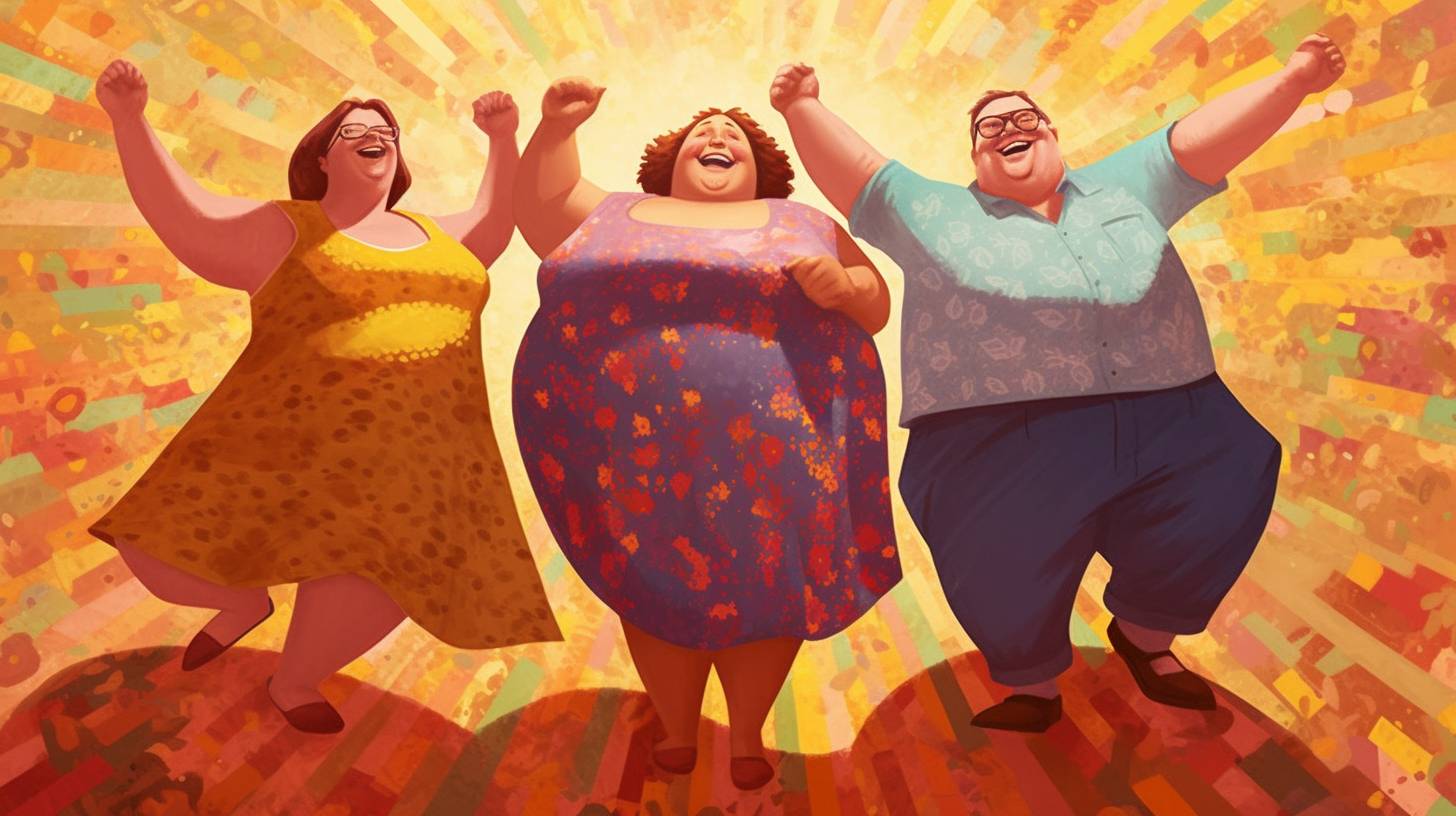Understanding the Differences Among Thick, Fat, and Chubby

A Comprehensive Guide to Identifying and Distinguishing Between Body Types
Key Takeaway:
- Thick, chubby, and fat are different body types that should not be equated with each other. Thick refers to a curvy body shape with a high muscle and low body fat percentage, while chubby refers to a body shape with excess fat accumulation in certain areas. On the other hand, fat refers to a body shape with high overall body fat percentage.
- The categorization of body types depends on genetics, body shape, and hips-to-waist ratio. It is important to avoid comparing oneself with unrealistic beauty standards and focus on self-confidence and acceptance.
- To stay in the optimum range, it is important to maintain a balanced diet, exercise regularly, and manage sleep and stress effectively. It is also important to understand the historical and current trends of celebrating diverse body types and recognize that opposite gender preferences can vary.
Introduction
In the world of body types, the terms thick, fat, and chubby are often used interchangeably, yet they have distinct differences. Thick refers to a curvy body with well-proportioned curves and toned muscles. Fat is the state of being overweight or having a high BMI. Chubby refers to someone who has a rounded, plump physique but falls within a healthy BMI range. It's essential to understand the differences between these terms to foster body positivity and diversity. Genetics, diet, and exercise can all play a role in these body types. However, it's crucial to prioritize inner beauty over an ideal body image.
If you're looking to adopt a healthier lifestyle, focus on natural foods and enjoyable exercise. Embrace fashion trends that make you feel confident and comfortable, regardless of your body type. A shift in mindset towards body positivity can help you appreciate your unique physique and appreciate others for their individuality. Remember, there is no one-size-fits-all solution when it comes to body types, and it's crucial to prioritize health over society's unrealistic expectations.
Understanding Different Body Types
Different individuals have varying body types, which can be categorized into different classifications. This article aims to provide insight into the distinctions between various body types such as thick, fat, and chubby.
To begin with, let's compare the differences between these body types in a table format:
| Body Type | Description |
|---|---|
| Thick | A person with a thicker body type has more muscle and less body fat than average. |
| Fat | A person who has excess body fat, which may be related to health concerns. |
| Chubby | A person who has a plump or rounded figure, with some excess body fat. |
It's important to acknowledge that every body type is unique, and there is no standard categorization for a 'perfect' or 'ideal' body type. Additionally, certain body types may be predisposed to certain health conditions or concerns such as obesity, which can impact overall health.
If an individual is looking to work towards a healthier lifestyle and improve their body type, there are a few suggestions to consider. Firstly, incorporating regular exercise and having a balanced diet can help in achieving a healthy body weight. Additionally, it's essential to consult a healthcare professional to establish a personalized health and fitness plan that suits an individual's unique needs and preferences.
Body Types
Body Types Explained
Understanding different body types is crucial for maintaining good health and self-esteem. Body types are generally classified into three categories - thick, chubby, and fat. Each body type has unique physical characteristics and requires specific attention to maintain a healthy lifestyle.
Table: Body Types Comparison
| Body Type | Physical Characteristics | Health Risks |
|---|---|---|
| Thick | Broad and muscular | None |
| Chubby | Rounded and soft | Obesity |
| Fat | Excess body fat | Various |
Thick bodies have broad and muscular structures that are generally healthy. On the other hand, chubby bodies have rounded and soft shapes, which can lead to obesity-related health risks if not taken care of properly. Fat bodies, having excess body fat, may pose several health risks such as heart diseases, diabetes, and high blood pressure.
To maintain a healthy lifestyle, it is important to consume a balanced diet and engage in regular physical activity that complements your body type. For instance, thick body types need more protein and weight training exercises to maintain muscle mass. Chubby body types can prioritize cardio exercises to burn excess fat and maintain a healthy weight. Finally, fat body types need a customized diet and expert guidance to burn excess fat and lead a healthier life.
Categorizing Yourself
Categorizing Your Body Type
Do you know the difference between thick, fat, and chubby? While these terms may seem interchangeable, they actually have distinct meanings. Thick refers to a body type with a curvy and voluptuous figure, while chubby refers to someone with a slightly heavier appearance. Fat, on the other hand, describes someone who is significantly overweight.
When it comes to the female physique, the difference between thick and chubby can be confusing. Thick generally refers to a woman with a fuller figure, while chubby is used to describe someone who is a bit overweight but not necessarily curvy. That being said, there are some women who are both thick and chubby.
It's important to note that one's weight and body type are not necessarily indicative of their overall health. In fact, studies have shown that being 'thin' doesn't necessarily mean one is healthy either. It's all about finding a balance and taking care of oneself.
Studies have shown that a diet high in processed food and lack of physical activity are major contributing factors to obesity. It's important to maintain a healthy lifestyle to mitigate the risk of diseases like diabetes and heart disease.
Interestingly, a study by the University of Chicago found that there is a correlation between sleep deprivation and weight gain. Lack of sleep affects the body's ability to metabolize carbohydrates, which can lead to weight gain.
Sources: University of Chicago, Healthline.
Staying in the Optimum Range
Maintaining an ideal body weight is crucial for a healthy life. Being overweight can lead to several health issues. Achieving the perfect body weight is not just about shedding those extra pounds, but also staying within the optimum range. This range is unique for every individual and can be determined by factors like age, sex, and height. Staying within this range can help prevent numerous health issues.
To stay within this range, one must maintain a healthy diet and exercise regularly. It is essential to strike a balance between calorie intake and calories burned. Understanding the difference between thick, fat, and chubby can also help in achieving this optimum weight. Thick refers to the broader body structure, while fat pertains to an excessive accumulation of body fat. Chubby is a term used for a person who is plump or slightly overweight, but not vastly.
Apart from a balanced diet and exercise, regular check-ups can also help in maintaining the ideal weight. These check-ups can highlight any health issues that may interfere with the weight loss and suggest suitable treatment options.
To achieve the perfect body weight and stay within the appropriate range, one must take small steps and be consistent in their efforts. Avoid binge eating, engage in physical activities regularly, and maintain a balanced diet. By doing so, you can avoid the health complications associated with being overweight, thereby leading a healthy life.
Keywords: fat vs chubby, thick chubby, chubby and thick, chubby thick, thick vs fat, fat vs thick, thick vs chubby, fat thick.
Trend Analysis
With the evolving society and changing preferences, the phenomenon of body types is gaining immense attention. Current Trend Analysis reflects people's fascination with differentiating terms like Thick, Fat, and Chubby.
Thick refers to having a broad and well-defined body structure, whereas Fat is a term used to describe excessive body fat. Chubby is relatively less offensive and refers to having a pleasingly plump body structure. The current Trend Analysis suggests that people are more accepting of the term "Thick" than "Fat".
The trend analysis reveals that body-shaming is prevalent on social media, and it generally targets obese individuals. It is vital to understand the negative impact of such derogatory terms and promote body positivity instead. Current trend analysis highlights the need to appreciate and accept all body types and promote inclusivity.
Embracing one's body type, following a balanced diet, and exercising regularly are some suggestions to promote a healthy lifestyle. Encouraging self-love and positivity also helps in building confidence and self-esteem. It is essential to understand the potential harm of using derogatory terms and promote a supportive and inclusive community.
Opposite Gender Preferences
Humans have an innate desire to establish romantic relationships. However, attractiveness varies from one person to the other, and the preference of an individual towards the opposite gender is unique. The tendency of an individual to prefer a particular set of characteristics in potential partners is referred to as Opposite Gender Preference.
Opposite Gender Preferences in 6 Points:
- Opposite Gender Preference is affected by societal norms and cultural background.
- Personality traits such as confidence, sense of humor, and kindness are typically attractive to the opposite gender.
- Physical appearance, including height, weight, and facial features, also play a crucial role in opposite gender preference.
- Economic status, education, and occupation can also affect the preference of an individual towards the opposite gender.
- Opposite gender preference can also change during different stages of life, including adolescence, early adulthood, and middle age.
- Most individuals are drawn towards partners who possess similar interests, values, and worldviews.
Unique Details:
Opposite Gender Preference is not only based on physical and economic factors but is also influenced by factors such as cultural and familial upbringing. Additionally, Opposite Gender Preference is not static but changes over time, and it is affected by environmental and societal factors.
True Story:
Julia, a successful entrepreneur, always had a preference towards funny and outgoing men. However, when she met George, a quiet and reserved engineer, she found herself attracted to him. They started dating, and over time, Julia realized that she valued George's introverted and analytical thinking over her previous preference for extroverted men. They are now happily married, and their unique Opposite Gender Preference has led to a fulfilling partnership.
Conclusion: What is Being Ideal?
Being Ideal: The Explanation
Achieving an ideal body type is a subjective and contextual concept affected by multiple socio-cultural factors. Society often perceives an "ideal" body as one that is aesthetically pleasing, healthy, and fit. However, individual perceptions of an ideal body vary based on personal experiences and cultural beliefs.
In some cultures, a fuller figure is considered ideal and represents wealth and status. Conversely, in western societies, a slim body type is often viewed as the standard of beauty. The notion of an ideal body has evolved over time. It is important to consider that each individual's idea of an ideal body is based on their experiences and perception of themselves and their surroundings.
When striving towards an ideal body type, it is essential to prioritize mental and physical health over perceived aesthetic standards. It is recommended to focus on maintaining a balanced diet and engaging in regular physical activities that suit personal preferences and physical abilities.
Moreover, it is important to acknowledge and embrace individual differences and avoid comparing oneself to others. Body positivity campaigns emphasize self-acceptance and appreciate all body types. Accepting oneself generates self-confidence and improves overall wellbeing, including mental health.
Five Facts About The Difference Between Thick, Fat, And Chubby:
- ✅ Thick, fat, and chubby are all used to describe body size, but they have different connotations and meanings.(Source: Healthline)
- ✅ Thick typically refers to someone with curves or a big butt and thighs, while fat refers to someone who is significantly overweight or obese.(Source: Insider)
- ✅ Chubby is a more lighthearted term for someone who is slightly overweight or with love handles.(Source: Verywell Fit)
- ✅ The body positivity movement has brought attention to the harmful effects of body shaming and the celebration of all body types and sizes.(Source: CNBC)
- ✅ It's important to prioritize health over size and to strive for a balanced and healthy lifestyle rather than focusing solely on appearance. (Source: Harvard Health Publishing)
FAQs about What Is The Difference Between Thick, Fat, And Chubby?
What is the difference between thick, fat, and chubby?
These terms are often used to describe a person's body shape or size, but they have different meanings. "Thick" usually means having a curvy body shape with fuller thighs, hips, and buttocks. "Fat" refers to a person being overweight or obese due to excessive body fat. "Chubby" suggests being slightly plump or having a rounded body shape.
Can the terms "thick," "fat," and "chubby" be considered offensive?
Yes, these terms can be considered derogatory and hurtful, especially when used to shame or insult someone. It's important to respect people of all body shapes and sizes and to use language that doesn't stigmatize them.
Is it possible to be healthy while being "thick," "fat," or "chubby?"
Yes, a person's body shape or size does not necessarily determine their overall health. It's possible for someone to have a heavier build but still be fit and healthy, while someone who appears thin may have poor eating habits or be physically unfit. It's important to focus on overall health and wellness rather than just body size.
What are some other terms that can be used to describe body shape and size?
There are many terms that can be used to describe body shape and size, such as "slim," "lean," "athletic," "curvy," "pear-shaped," "hourglass," etc. It's important to remember that everyone's body is unique and deserves respect, regardless of how it appears.
How should I talk about someone's body shape or size?
It's best to avoid commenting on someone's body shape or size unless it's relevant or necessary. When it is necessary, try to use neutral and descriptive language that doesn't stigmatize or shame the person. Remember that everyone deserves to feel comfortable and accepted in their own body.
What can I do to support body positivity and acceptance?
One way to support body positivity and acceptance is to challenge negative stereotypes and language surrounding body size and shape. Encourage and celebrate diversity, and try to appreciate and respect people of all sizes and shapes. Promote healthy and positive attitudes towards food and exercise, and resist societal pressure to conform to restrictive beauty standards.


